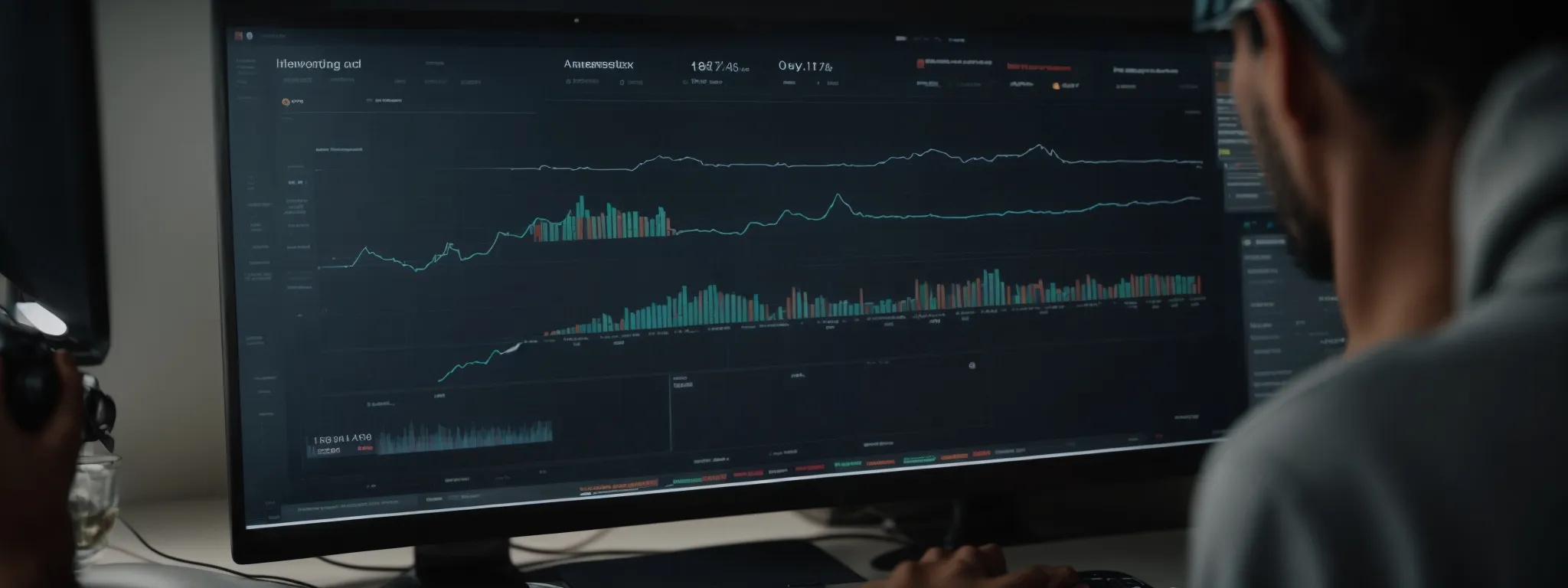Your Guide to URL SEO
Maximizing Your Website’s Potential With URL SEO: Your Comprehensive Guide Navigating the complexities of URL optimization can dramatically sharpen a brand’s digital edge, turning overlooked aspects of […]
Maximizing Your Website’s Potential With URL SEO: Your Comprehensive Guide
Navigating the complexities of URL optimization can dramatically sharpen a brand’s digital edge, turning overlooked aspects of web design into robust tools for enhancing search visibility.
A meticulously structured URL not only guides a visitor seamlessly through a website’s terrain but also communicates valuable information to search engines, bolstering a site’s SEO ranking potential.
With strategic use of keywords, concision, and clarity, businesses can sculpt URLs that serve as potent beacons to both users and algorithms.
Keep reading to unlock the full spectrum of URL strategies that can amplify your site’s SEO results and drive meaningful traffic.
Key Takeaways
- A Well-Structured URL Enhances Site SEO and User Accessibility
- Utilizing the Correct Top-Level Domains and URL Substructures Aligns With Brand Identity and SEO Goals
- Strategic Use of Canonical Tags and 301 Redirects Preserves SEO Value During Site Updates
- Optimizing URL Length and Avoiding Excess Complexity Benefit User Experience and SEO Performance
- Proper Management of URL Parameters and International Structuring Are Crucial for Global SEO Success
Understanding the Essentials of URL Structure for SEO

When embarking on the journey to maximize a website’s potential through search engine optimization, professionals often overlook the importance of a well-crafted URL.
A meticulous approach to defining an SEO-friendly URL structure sets a solid foundation for a site’s digital footprint, influencing how search engines interpret and rank web pages.
It is essential to recognize the impact that top-level domains hold in establishing domain authority and trustworthiness.
Furthermore, striking the right balance with the use of subdomains and subfolders can affect the site architecture, which in turn shapes user behavior and search visibility.
By mastering these components, businesses position themselves to enhance their online presence significantly.
Define an SEO-friendly URL Structure
An SEO-friendly URL structure is more than a mere web address; it acts as a clear signpost guiding both users and search engines through a website’s content hierarchy. Prioritizing brevity, clarity, and keyword relevance, the right URL structure reinforces the theme of a webpage, contributing to its overall search engine rankings and user accessibility.
LinkGraph’s SEO Expertise emphasizes the creation of URLs that are devoid of unnecessary parameters and underscores, opting instead for hyphenated phrases that mirror the page content. By crafting URLs that succinctly convey the topic at hand and include the target keyword, LinkGraph ensures that search engines and visitors alike comprehend the page’s primary focus, bolstering search visibility and enhancing user experience.
Recognize the Impact of Top-Level Domains
Top-level domains (TLDs) possess a pivotal role in SEO by signaling to search engines the nature and geographical association of a website: They are the final segment of a domain name, like .com, .org, or country-specific endings such as .uk or .de.
- Businesses must judiciously select a TLD that resonates with their brand identity and customer base, ensuring alignment with their marketing strategy and SEO objectives.
- Moreover, TLDs can influence user perception, as certain domains carry connotations of credibility and professionalism, potentially impacting click-through rates (CTR) and digital reputation.
Incorporating the most pertinent TLD enhances domain authority and bolsters trust, which are decisive factors in Google’s ranking algorithms: A strong domain instills confidence in users and search algorithms alike, lending credibility to the site’s content and offerings.
Explore the Use of Subdomains and Subfolders
The Strategic Deployment of Subdomains and subfolders presents an intricate yet crucial aspect of URL structuring for SEO optimization. Subdomains, serving as separate entities, enable businesses to organize content that distinctly diverges from the main site’s theme, such as a dedicated e-commerce platform or a blog with a different focus: Conversely, subfolders, or directories, maintain a closer association with the core domain, often used for categorizing content under the main website umbrella, which can positively influence the site’s search engine rankings.
| Content Type | Subdomain Example | Subfolder Example |
|---|---|---|
| E-commerce Platform | shop.example.com | example.com/shop |
| Corporate Blog | blog.example.com | example.com/blog |
| Support Portal | support.example.com | example.com/support |
Understanding the distinction and appropriate application of these structures is instrumental: While search engines commonly view subdomains as separate from the main domain, leading to potential dilution of domain authority, they consider subfolders as part of the main domain’s content, potentially consolidating and strengthening the website’s overall SEO prowess. Thus, LinkGraph advises its clients on choosing the structure that best aligns with their specific digital marketing strategy, ensuring the organization’s web presence is meticulously mapped for optimal search visibility.
Crafting Optimized and Descriptive URLs

In the digital era, a website’s URL serves as more than just a navigational aid; it’s a vital component of a comprehensive SEO strategy, playing a significant role in how a site is understood and ranked by search engines.
By meticulously weaving targeted keywords into the very fabric of a site’s URLs, businesses enhance the relevance and authority of their digital domain.
Emphasizing brevity and readability ensures that these web addresses are user-friendly, while the judicious use of hyphens ties together words in a way that is both aesthetically pleasing and structurally beneficial from an SEO standpoint.
Understanding and implementing these tactics is pivotal for any entity looking to reinforce its online presence and maximize search engine rankings.
Integrate Relevant Keywords Into Your URLs
Incorporating relevant keywords into a website’s URL structure not only clarifies the content of the page to visitors but also communicates the page’s subject matter to search engines. LinkGraph, a provider of top-tier SEO services, guides clients through the meticulous process of identifying and embedding Target Keywords that align with the visitors’ search intent and the content of the page to improve search rankings.
LinkGraph’s approach involves thorough keyword research to ensure that the chosen phrases accurately reflect the content and offerings of the web page. This integral facet of on-page SEO augments the relevance and discoverability of a page within search engines, favorably impacting the site’s search engine results page (SERP) position:
| Original URL | Keyword-Optimized URL | Target Keyword |
|---|---|---|
| example.com/item123 | example.com/handcrafted-wooden-toys | Handcrafted Wooden Toys |
| example.com/service456 | example.com/professional-painting-services | Professional Painting Services |
| example.com/article789 | example.com/seo-strategy-guide | SEO Strategy Guide |
Keep Your URLs Concise and Readable
Clarity and ease of navigation are the cornerstones of effective URL structures, demanding that URLs remain both succinct and intelligible. URLs replete with clarity not only ensure a seamless user experience but also contribute to a site’s search engine friendliness, leveraging brevity as a tool for higher search engine rankings.
LinkGraph accentuates the importance of crafting URLs that are devoid of superfluous characters and unwieldy strings, steering clear of convoluted or ambiguous references. This Focus on Readability and simplicity aids in telegraphing a page’s subject matter crisply to users and search engines, which is vital for bolstering a site’s search visibility and click-through rates.
Utilize Hyphens to Separate Words
LinkGraph’s expertise in search engine optimization reveals a preference for the use of hyphens in URLs, as it significantly enhances legibility. Visitors and search engines alike favor a URL structure where words are distinctly separated by hyphens, eschewing the confusion that underscores or continuous strings of text can generate. This deliberate choice in punctuation aids in emulating natural language, thus enabling both the user and search algorithms to parse the URL with ease.
The utility of hyphens extends beyond mere aesthetics; it contributes to a URL’s efficiency in conveying meaning and context. LinkGraph’s SEO professionals recommend this approach because it mirrors the text’s readability on the page, improving the flow and comprehension at a glance. Hyphenation stands as a minor but essential detail that underscores a well-optimized URL, reflecting best practices in facilitating both human understanding and search engine indexing.
Mastering the Use of Canonical URLs

Advancing to higher echelons of search engine optimization requires a keen understanding of canonical URLs, an integral element within the SEO toolkit for addressing the complexities of duplicate content.
As businesses proliferate content across various pages, the strategic use of canonical tags becomes indispensable in preserving the SEO value of a website.
By identifying the most authoritative page for a given piece of content, canonical tags direct search engine crawlers, helping to manage duplicate content effectively and maintain a cohesive site architecture.
This proactive stance in the implementation of canonical tags not only streamlines search engine indexing but also consolidates ranking signals, reinforcing the online authority and search relevance of a website’s core offerings.
Identify and Tag Canonical URLs
Identifying the correct canonical URL for a piece of content is a vital step for maintaining the integrity of search engine optimization efforts. By designating a preferred URL, businesses instruct search engines on which version of a page is to be considered the flagship content, thereby avoiding issues of content duplication.
The process of tagging canonical URLs involves several essential steps that ensure search engines recognize the primary source for content distribution across multiple pages:
- Conduct a meticulous site audit to uncover all variations of duplicate or similar content.
- Select the version of the content that provides the most value to users and has the strongest SEO potential.
- Implement rel=”canonical” tags in the header section of duplicate pages to point towards the chosen canonical URL.
LinkGraph employs this strategy meticulously, as part of its comprehensive SEO services to solidify clients’ site rankings and prevent dilution of link equity. With the appropriate use of canonical URLs, LinkGraph ensures search engines consolidate all SEO signals to the preferred URL, enhancing a site’s prominence in search results.
Manage Duplicate Content With Canonical Tags
LinkGraph’s strategic use of canonical tags serves as an effective mechanism for managing duplicate content, ensuring that search engines prioritize the most authoritative page in their ranking algorithms. This technique signals which URL should be deemed the original source, thus preventing dilution of link equity and preserving the SEO strength of the primary content.
Employing the nuanced approach of canonicalization, LinkGraph’s SEO experts adeptly mitigate the common pitfall of content redundancy which can confuse search algorithms and impact website rankings. Through this method, a clear hierarchy of content is established, allowing search engines to consolidate ranking power and drive more targeted traffic to the designated main page.
The Role of URL Length in SEO Performance

The precise orchestration of URL length plays a pivotal role in the search engine optimization landscape, where brevity intersects with informativeness to influence a website’s SEO performance.
Straddling this fine line requires a discerning look at the length to ensure URLs are not only conducive to search engine algorithms but also to user experience.
In the following passages, one will unravel the attributes characterizing an ideal URL length, as well as unpack the complications that arise from excessively elongated URLs.
Thus begins the exploration into optimizing URL length for heightened SEO efficacy.
Analyze the Ideal URL Length
SEO veterans recognize the conundrum of URL length: too short may lack descriptive power, too long risks being truncated or diluted in relevance. LinkGraph strikes an optimal balance, curating URLs that succinctly encapsulate key information while remaining well within the threshold of what search engines and users favor, resulting in URLs that cater to both clarity and performance metrics.
Empirical data suggests that shorter URLs tend to perform better in search rankings, a principle LinkGraph applies by keeping web addresses pithy without forgoing necessary detail. This strategic distillation ensures that each URL is poised to leverage maximum SEO value, enhancing a website’s capacity to climb SERPs and assert its digital presence with precision.
Discover the Implications of Overly Long URLs
Overly long URLs pose a significant challenge in SEO by compromising both user experience and search engine readability: Lengthy and complicated web addresses can deter users from clicking through, potentially lowering a site’s click-through rates. Moreover, verbose URLs may be truncated in the search results, obscuring vital information that could have influenced a user’s decision to visit the site.
Search engine algorithms often favor conciseness, a tendency that penalizes websites saddled with unwieldy URLs: Pages with disproportionately long URLs may suffer in rankings as they can overwhelm search engine crawlers and dilute keyword relevance, negatively impacting the website’s search visibility and efficacy within the digital marketplace.
| Aspect of URL Length | User Experience Impact | SEO Performance Impact |
|---|---|---|
| Excessive Length | Reduces click-through rates | Potential for lower search rankings |
| Verbosity | Possibility of being truncated in search results | Keyword dilution and lower search visibility |
| Complexity | Decreases user trust and clarity | Challenges search engine crawling efficiency |
Implementing 301 Redirects for SEO Benefits

Seamless navigation and maintaining the integrity of link equity are cornerstones of robust SEO practices.
As businesses evolve, change becomes inevitable, leading to website restructuring and content migration.
This progression often necessitates the implementation of 301 redirects—a measure that ensures users and search engines are guided to the correct pages, despite changes in URL structures.
Harnessing the power of 301 redirects not only preserves the user experience but also safeguards a site’s accumulated SEO value.
The following discourse will elucidate how to conceive an astute 301 redirect strategy and maintain link equity, solidifying the online stature of a brand in the ever-dynamic realm of digital marketing.
Plan Your 301 Redirect Strategy
A comprehensive 301 redirect strategy serves as a vital contingency plan during website transitions, safeguarding both user experience and search engine ranking. LinkGraph professionals assist clients in mapping out an intricate redirection blueprint, ensuring a smooth transfer of SEO value from old to updated URLs, adeptly preventing any disruption in site performance or visitor navigation.
Applying 301 redirects correctly consolidates the integrity of a website’s link profile, a process LinkGraph meticulously undertakes by analyzing webpages for outdated links and mapping them to the most relevant, live content. This strategic approach prevents the loss of hard-earned link juice, thereby maintaining a brand’s stature in the digital landscape and bolstering its search visibility post-transition.
Preserve Link Equity With Proper Redirects
LinkGraph practices precision in the realm of 301 redirects to ensure the SEO value built over time is not diminished but rather carried over to the new URL destinations. Their experts discerningly implement these redirects to maintain a website’s traffic flow and domain authority, demonstrating the importance of seamlessly migrating SEO strength from outdated URLs to their current iterations, which is critical for a website’s longevity in the rankings.
In the intricate digital ecosystem where link equity serves as currency, proper utilization of 301 redirects by LinkGraph emerges as an essential preservation tactic. This meticulous redirection of inbound links to the updated content preserves the intrinsic value of previous SEO endeavors, thereby reinforcing a brand’s visibility in the eyes of search engines while maintaining a consistent user experience across the website’s changing landscape.
Avoiding Common URL SEO Mistakes

As businesses progress in tailoring their URL strategies for search engine optimization, the importance of vigilant oversight becomes apparent to avert the pitfalls that could undermine a website’s search rankings.
Recognizing and rectifying broken links forms an essential part of this scrutiny, ensuring that the integrity of the site remains intact and all pathways lead to relevant, live content.
Likewise, the update or elimination of outdated URL parameters is critical to maintaining a clean and efficient online presence—actions that, when executed methodically, fortify the website’s relevance and search visibility.
By addressing these issues proactively, companies can secure their digital presence and avoid the detriments associated with common URL SEO oversights.
Identify and Fix Broken Links
Meticulous vigilance in identifying and remedying broken links constitutes a critical aspect of URL SEO. LinkGraph’s consummate professionals are adept at utilizing sophisticated tools to streamline the detection of non-functional URLs, preemptively addressing disruptions in site navigability and search engine crawlers’ access to content, which could potentially tarnish a site’s SEO profile.
Once located, broken links are swiftly rehabilitated or rerouted with precision, an essential step in a well-maintained SEO strategy. LinkGraph’s commitment to URL integrity ensures that all pathways within a website lead to the intended destination, fostering trust among visitors and maintaining uninterrupted link equity that supports optimal search engine ranking.
Update or Remove Outdated URL Parameters
Outdated URL parameters can clutter a website’s architecture with unnecessary complexity, a challenge that LinkGraph systematically addresses by advising clients to pare down or update these elements. This smart optimization enhances the clarity and sustainability of the site’s URL structure, reinforcing its potential to rank competently within search engine results pages.
By refining URL parameters, LinkGraph not only streamlines a website’s navigation but also bolsters its SEO health. Accurate adjustments to URL parameters reduce crawl errors and page load times, ensuring that search engines favor the website’s content with improved rankings and heightened online visibility.
Enhancing SEO With Dynamic URL Parameters

In the quest for search engine optimization supremacy, dynamic URL parameters stand as powerful but often misunderstood tools within a webmaster’s arsenal.
These adjustable elements play a pivotal role in tracking user engagement and refining content accessibility, yet they also present a unique set of challenges for maintaining SEO integrity.
Properly managed, URL parameters have the potential to unveil invaluable insights into user behavior and site performance, while simultaneously streamlining the user experience.
In the discussions to follow, pivotal strategies for leveraging URL parameters for tracking, sorting, and minimizing their indexing when they offer no SEO benefit, will be explored to ensure that while they serve their purpose, they don’t inadvertently hinder your website’s search engine standing.
Use URL Parameters for Tracking and Sorting
In the realm of digital analytics, URL parameters are crucial for tracking user engagement and understanding visitor pathways. They provide granular data that reveal the preferences and actions of users, which can inform strategic adjustments to enhance marketing efforts and website functionality.
When utilized effectively, URL parameters can transform a standard URL into a sophisticated tool for sorting content according to user-specific criteria, such as price or relevance:
- Utilizing parameters allows for the dynamic organization of products or articles based on user selections, streamlining the browsing experience.
- Parameters are integral to A/B testing, enabling webmasters to present different versions of a page to users in order to gauge performance and preference.
- Effectively implemented tracking parameters can furnish invaluable insights into the efficacy of digital advertising campaigns by pinpointing the origin of traffic and conversions.
Minimize Indexing of Unnecessary URL Variations
Considering the multifaceted nature of modern websites, search engines may encounter countless variations of a URL due to dynamic parameters. To safeguard against potential SEO challenges, such as diluted page authority or content duplication, LinkGraph advises clients on strategies to curtail the indexing of non-essential URL variations: This entails instructive communication with search engine crawlers about which pages to ignore, preserving the site’s SEO integrity.
- Implementing the robots.txt file to block specific parameter-laden URLs from being crawled.
- Employing the ‘noindex’ directive to prevent certain pages from being indexed.
- Using Google Search Console to signal to Google which parameters to disregard.
These measures are an integral component of the comprehensive SEO services offered by LinkGraph, ensuring that search engine resources are concentrated on indexing the most valuable content. By minimizing superfluous URL indexing, businesses maintain streamlined, high-impact websites that resonate with search algorithms and foster search visibility.
SEO Strategies for Multilingual and International URLs

In an increasingly globalized marketplace, the ability to connect with an international audience is imperative for any competitive brand.
Navigating the complexities of multilingual and international search engine optimization demands astute attention to the structure and localization of website URLs.
This segment will illustrate pivotal strategies for customizing URLs to resonate across varied linguistic landscapes and geographic domains.
From creating language-specific URLs to tailoring site addresses to engage specific countries or regions effectively, these finely honed tactics are crucial in capturing the diverse needs of a global user base and enhancing a brand’s international footprint.
Structure Your URLs for Different Languages
As corporations extend their reach globally, structuring URLs to accommodate different languages becomes an intricate part of international SEO. Such arrangements enable search engines to serve the most appropriate language version of a website to users, based on their location and browser settings.
LinkGraph cautions that without meticulous structuring of URLs for multilingual content, brands risk alienating non-English speaking audiences and diminishing their search visibility in international markets. To illustrate this approach, consider the table below showcasing strategic URL configurations for a multinational presence:
| Language | URL Example |
|---|---|
| English (United States) | www.example.com/en-us/ |
| Spanish (Spain) | www.example.com/es-es/ |
| French (France) | www.example.com/fr-fr/ |
Tailor URLs to Target Specific Countries or Regions
In sculpting a website’s URL structure for an international audience, LinkGraph stands as a beacon of expertise, providing local SEO services that deftly allocate region-specific URLs. This targeting not only enhances the relevance for users in different geographic areas but also signals to search engines the localized nature of content, optimizing visibility within regional search results.
LinkGraph understands the value of geo-targeting through URL customization, where leveraging country code top-level domains (ccTLDs) or subdirectory structures pertinent to each region can propel a brand’s resonance across borders. Such deliberate strategies marshal the precision of SEO efforts to meet the user where they are, fostering engagement and improving search performance in targeted locales.
Measuring the Impact of URL Changes on SEO

Understanding the repercussions of alterations made to a website’s URL structure on SEO metrics is paramount for any business seeking heightened online prowess.
Meticulous tracking and interpretation of analytic data post-URL modification provide a wealth of insight into the efficacy of these changes.
Businesses must be prepared to adapt their strategies in response to the information gleaned from URL performance evaluations.
Only through the thoughtful analysis of this data can a recalibration of tactics be executed, ensuring that every element of a website’s URL contributes positively to its overall search engine optimization footprint.
Track Your URLs’ Performance With Analytics
Assessing the SEO impact of URL modifications is critical, and so businesses rely on LinkGraph’s proficiency in tracking performance through comprehensive analytics. The refined data insights gained spotlight which changes to the URL structure are enhancing search visibility and user engagement, while also identifying those adjustments that may require further optimization.
Employing advanced analytics, clients receive detailed reporting on URL performance, understanding the direct correlation between URL alterations and shifts in SEO metrics. LinkGraph utilizes these analytics to refine strategies and ensure that each URL continues to contribute positively to a website’s search engine success:
- Tracking key performance indicators such as page views, bounce rates, and conversion rates linked to specific URL changes.
- Examining the flow of organic traffic to determine how new URLs fare in attracting and retaining visitors.
- Analyzing click-through rates (CTR) from search results to evaluate the effectiveness of URL readability and keyword inclusion.
Effective URL tracking and analysis not only illuminate the web page’s health but also fortify ongoing SEO efforts. Through this meticulous evaluation, LinkGraph ensures that the structural elements of a website’s URLs contribute powerfully to achieving and maintaining high search engine rankings.
Adjust Your Strategy Based on URL Performance Data
LinkGraph’s adept analysis of URL performance data stands at the helm of driving strategic SEO decisions, Empowering Businesses to Finetune their tactics in the light of empirical evidence. Discerning patterns in user interaction with URLs guide the optimization process, enabling targeted enhancements that bolster a site’s SEO stature.
Reacting swiftly to data-driven insights allows a nimble transformation of a brand’s URL approach, where LinkGraph identifies opportunities for improvement and promptly executes refinements. This dynamic calibration, rooted in solid analytics, fortifies a website’s ability to compete effectively on the evolving battleground of search engine results.
Conclusion
In conclusion, crafting an effective URL SEO strategy is a critical component in maximizing a website’s potential.
A clear, concise, and structured URL not only enhances user experience but also significantly impacts search visibility and rankings.
Selecting the right top-level domain (TLD) establishes domain authority while the strategic use of subdomains and subfolders can influence a website’s architecture and SEO.
Including relevant keywords, maintaining URL brevity, and employing hyphens for readability are essential practices for optimizing URLs.
Furthermore, implementing canonical URLs and 301 redirects preserves link equity and manages duplicate content efficiently.
Monitoring and adjusting strategies based on URL performance analytics ensure the ongoing effectiveness of a site’s SEO efforts.
By avoiding common mistakes and leveraging dynamic URL parameters intelligently, websites can sustain robust online presences that captivate both users and search engines globally.














































































